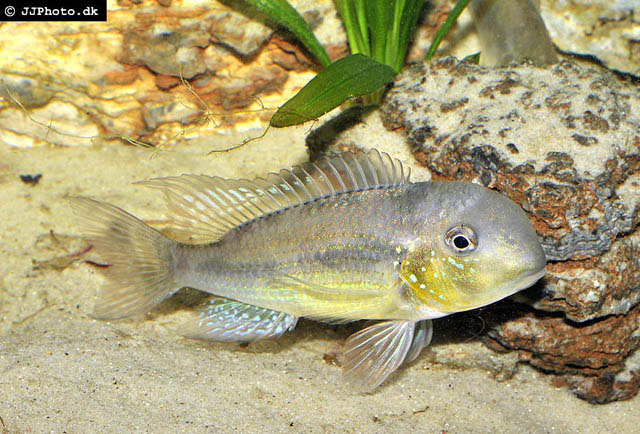| Cichlidae (Cichlids), subfamily: Geophaginae |
| 10.2 cm SL (male/unsexed) |
|
benthopelagic; freshwater |
| South America: middle rio Negro basin, including main tributaries (lower rio Uruguay basin) and in rio Tacuarí (laguna Mirim basin). |
|
Dorsal spines (total): 13-16; Dorsal soft rays (total): 7-12; Anal spines: 3-3; Anal soft rays: 6-9. Diagnosed from all congeners by having the following unique characters: adipose hump on head deeper than the dorsal-fin upper border, adipose hump with anterior profile vertical, extending from the upper lip to the dorsal-fin origin; absence of transversal bands on body; two horizontal series of moderately elongated light blue dots between dorsal-fin spines; a series of light blue stripes between soft rays, sometimes merged with the second series of elongated dots, and always with a red ground color between series of dots; and caudal fin with dots vertically aligned on its distal border. Other characters useful to differentiate it from other species include: E1 scale count 27-30, 96% with 28-30 (vs. 26-29, 74% with 26-27 in Gymnogeophagus gymnogenys); absence of a black line anterior to eye (vs. present in Gymnogeophagus gymnogenys and Gymnogeophagus caguazuensis); body depth 33.6-41.4% SL (vs. 23-29% SL and 41.2-43.3% SL in Gymnogeophagus gymnogenys and Gymnogeophagus australis, respectively). Differs further from Gymnogeophagus australis by the following characters: presence of six to eight parallel light green bands on body (vs. absence); snout to dorsal-fin origin length 30.5-38.4% SL (vs. 23.6-30.7% SL); and head depth 81-104% HL (vs. 109.7-116.2% HL) (Ref. 80696). |
| Found in large rivers with clear water, sandy or rocky bottoms and with little vegetation (Ref. 80696). Females were encountered holding juveniles in their mouths during the end of spring and summer (Ref. 80696). |
|
Least Concern (LC); Date assessed: 19 November 2020 Ref. (130435)
|
| harmless |
Source and more info: www.fishbase.org. For personal, classroom, and other internal use only. Not for publication.

